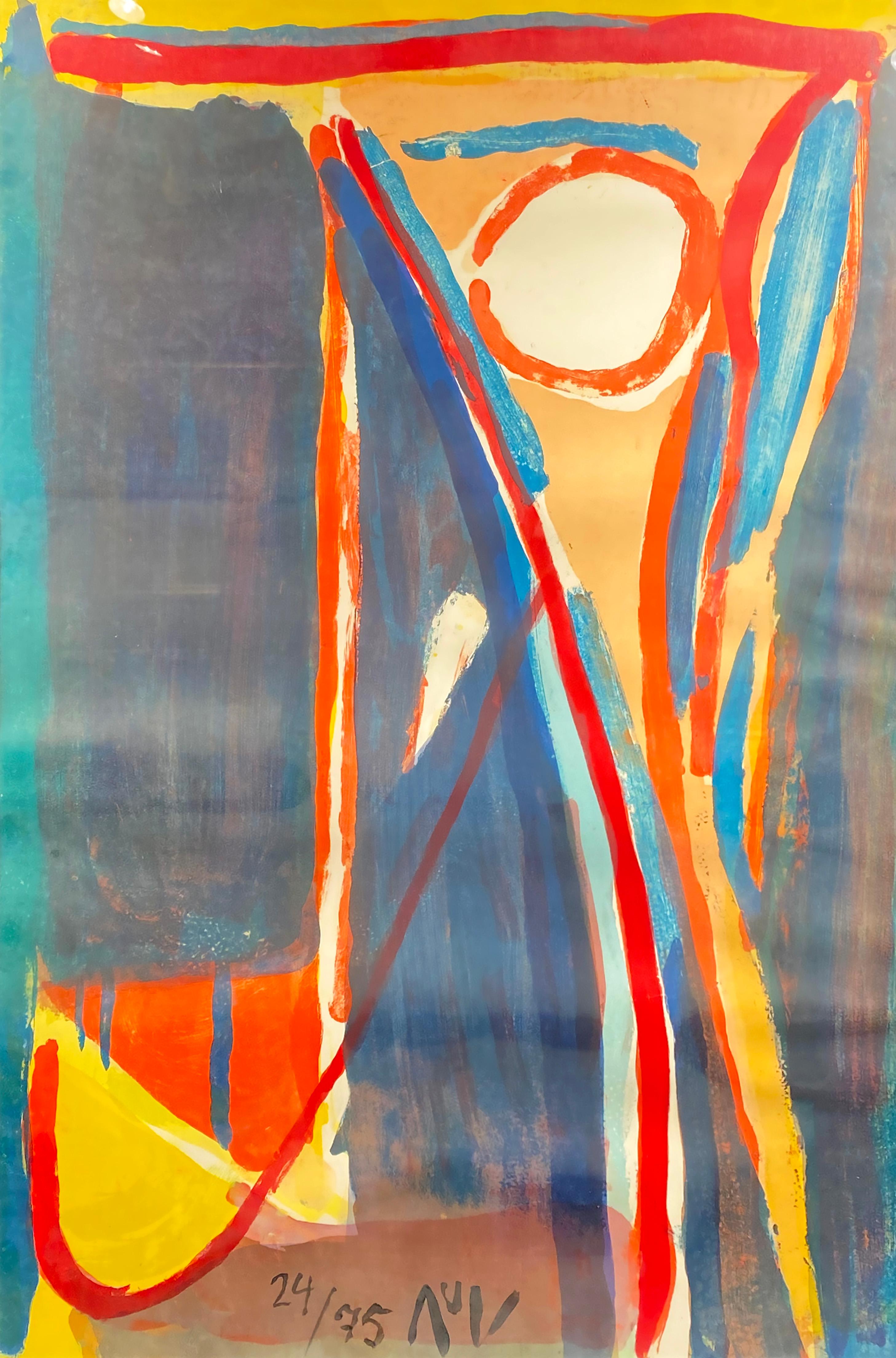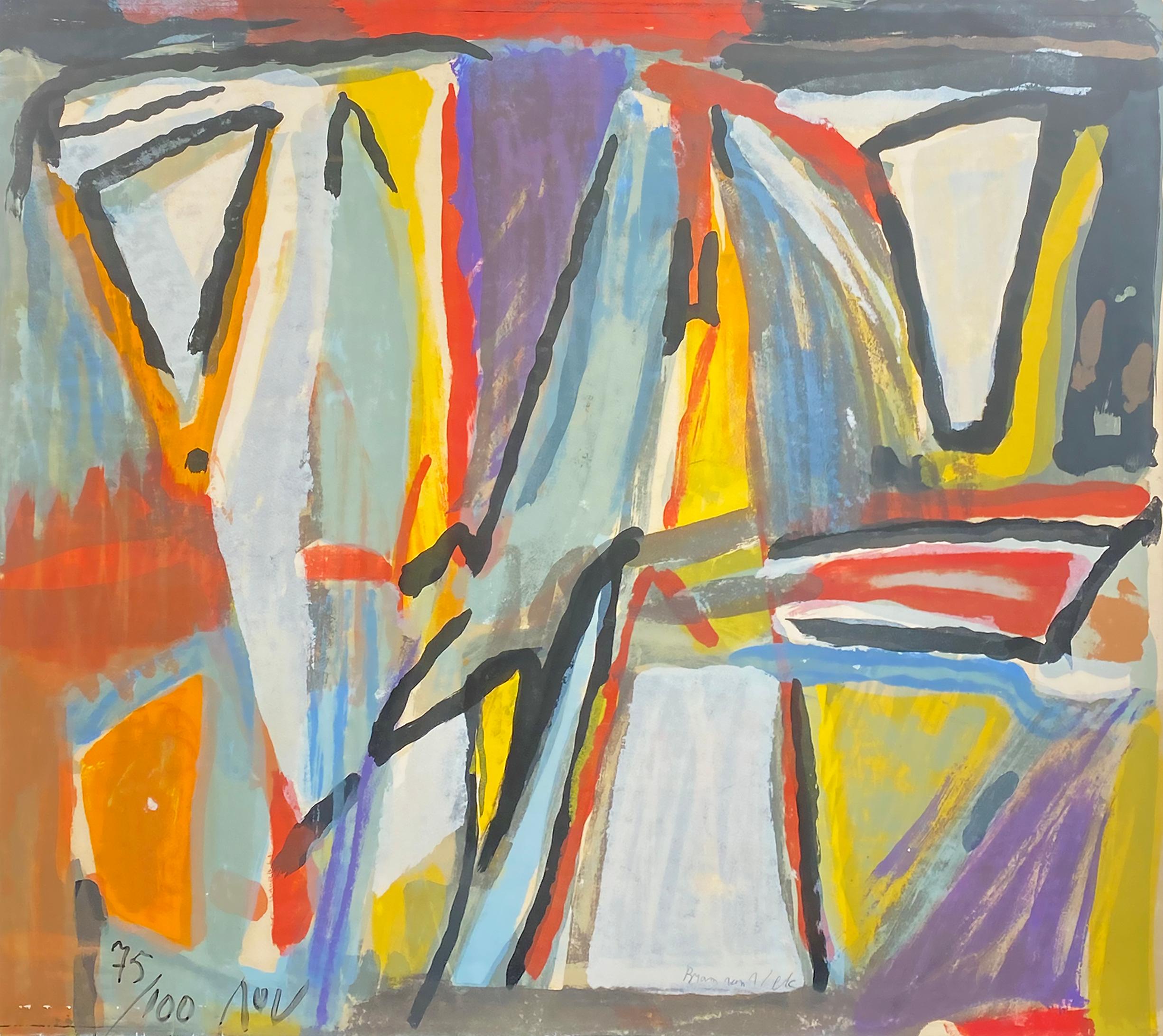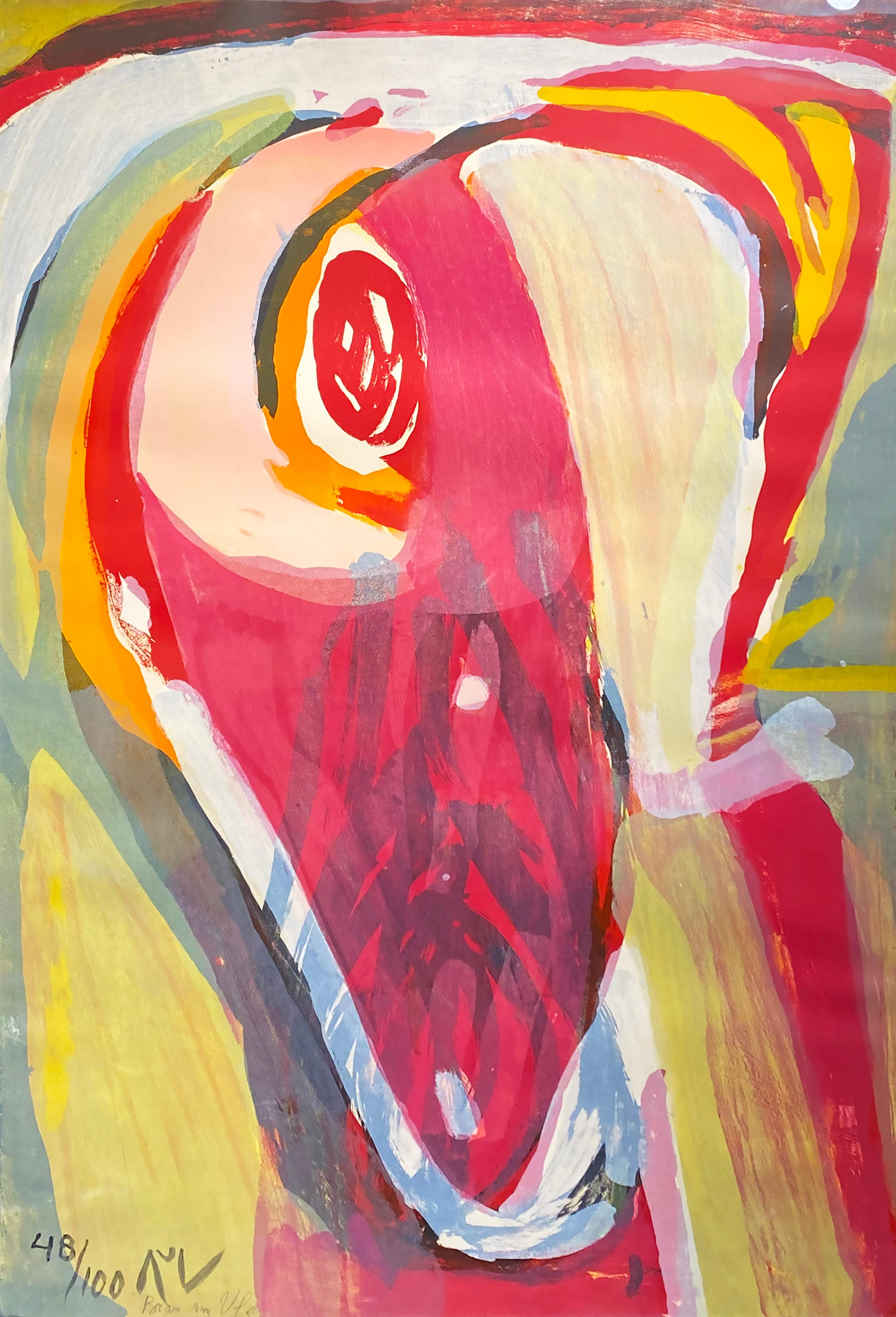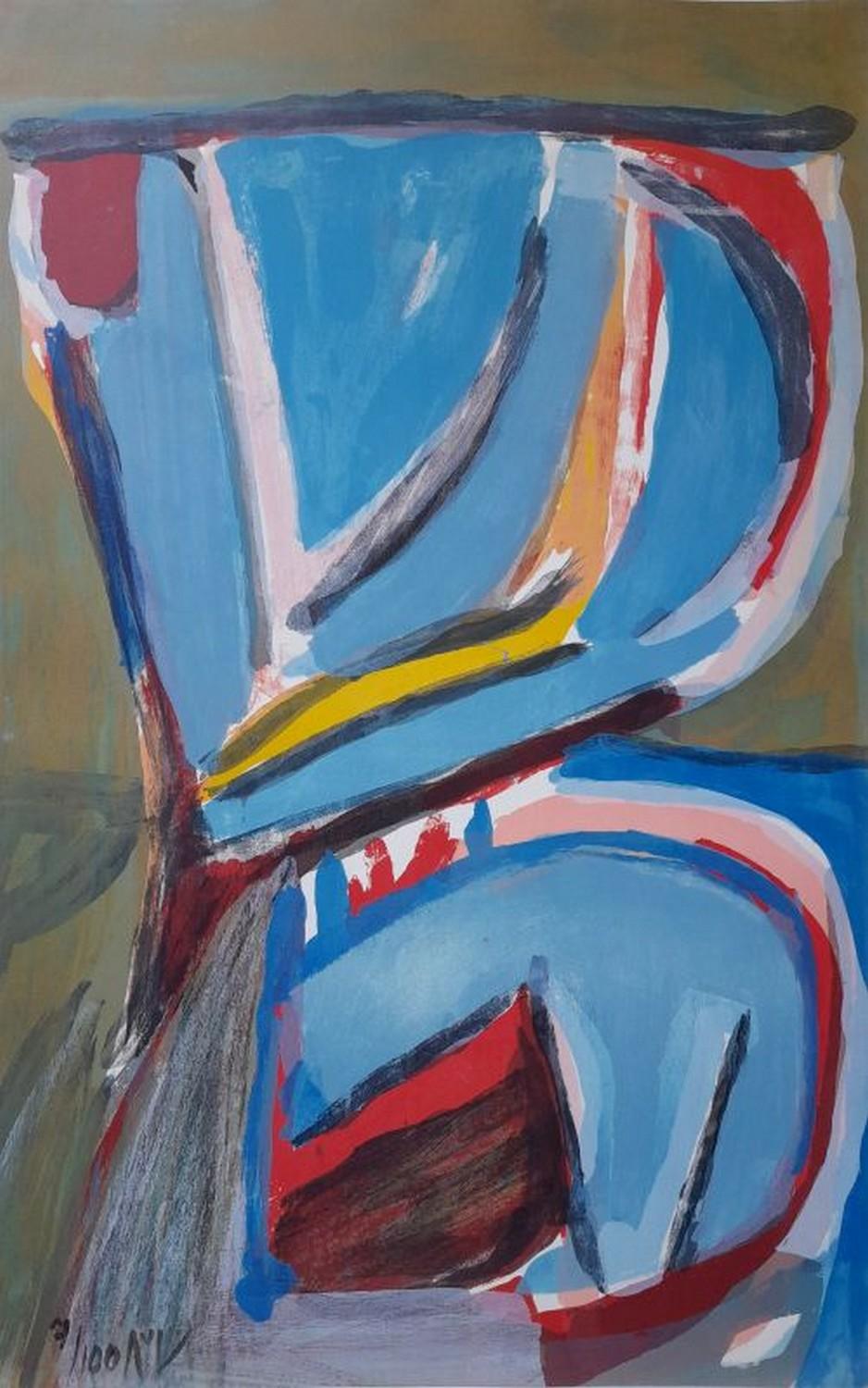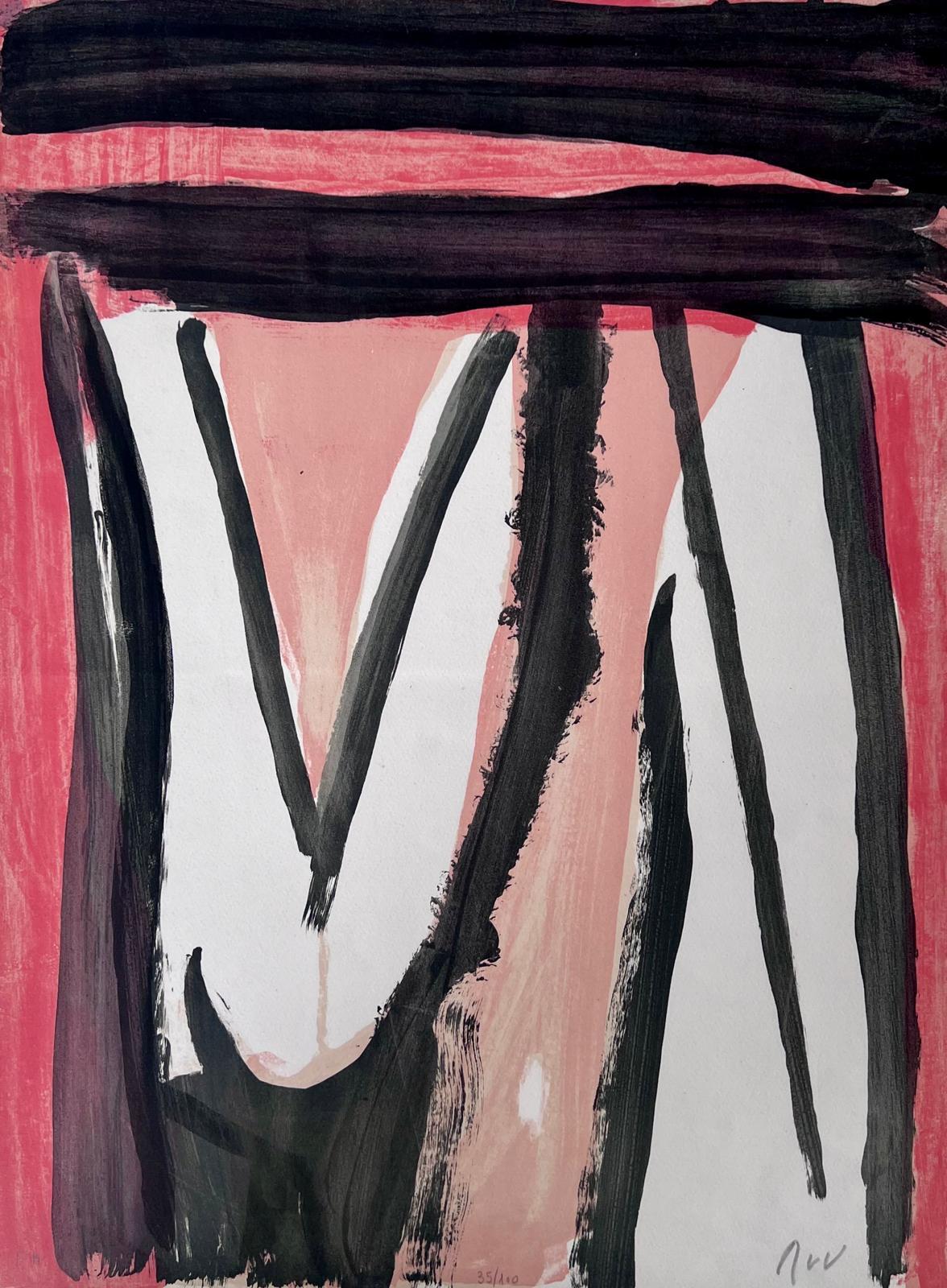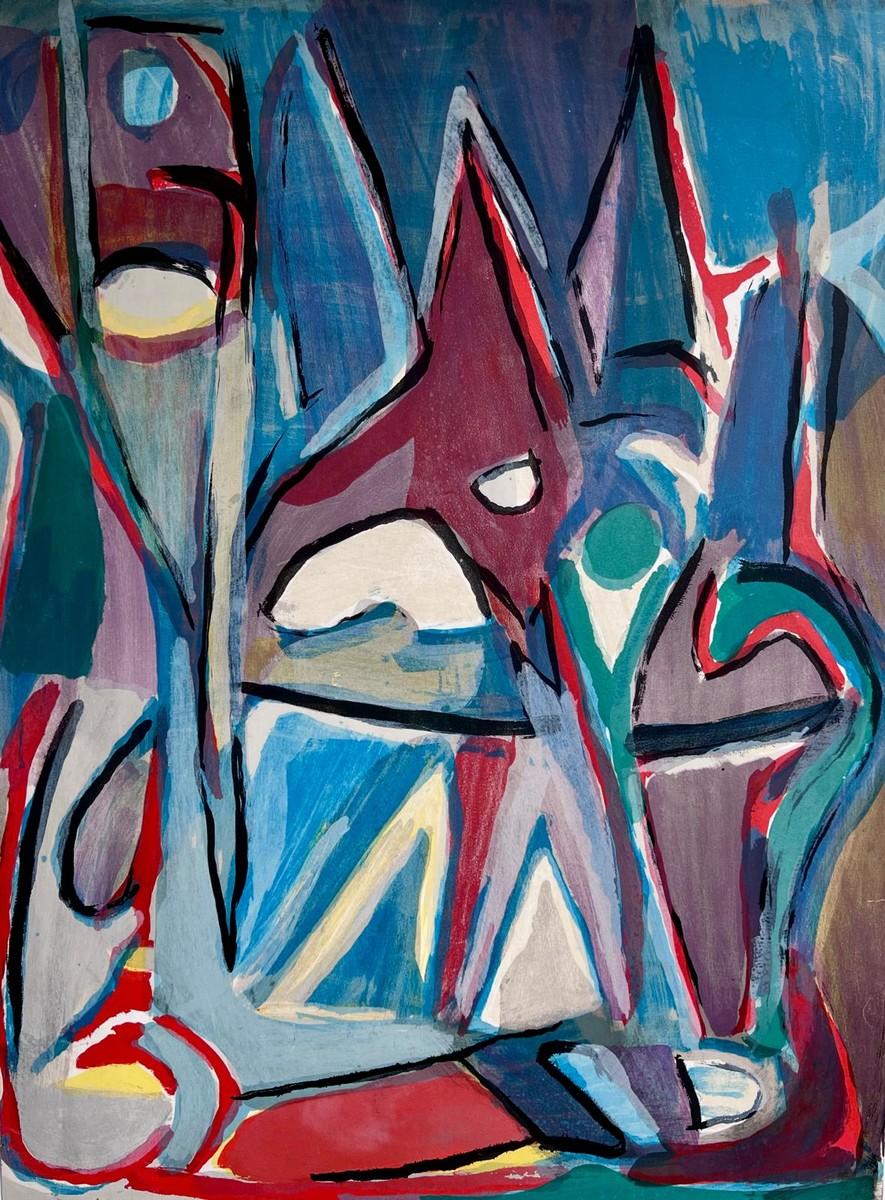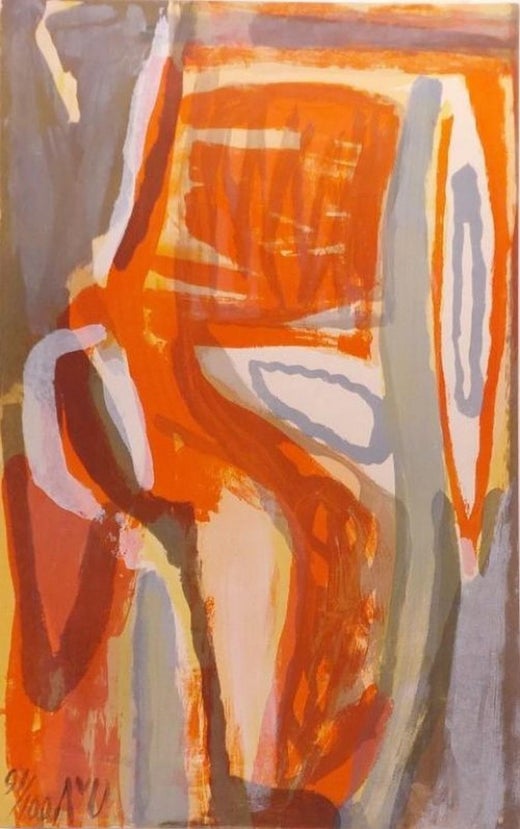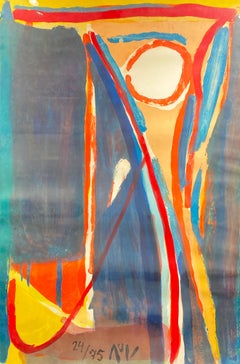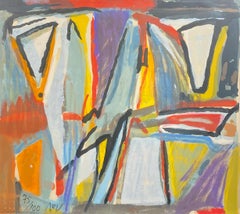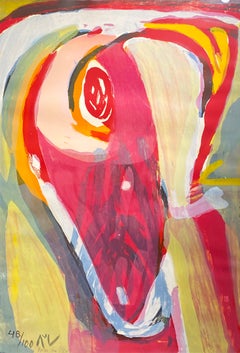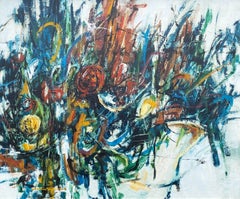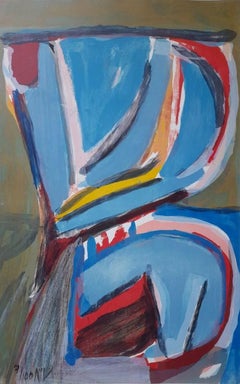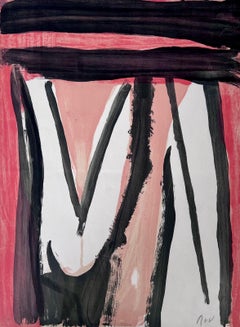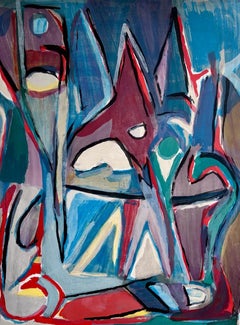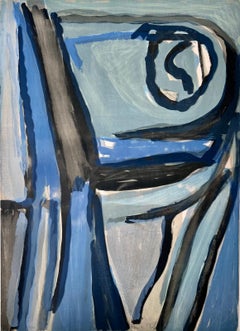Want more images or videos?
Request additional images or videos from the seller
1 of 13
Bram Van VeldeAbstract (Edition 95/100)Unknown
Unknown
Price Upon Request
Price Upon Request
Price Upon Request
Price Upon Request
Price Upon Request
Price Upon Request
Price Upon Request
Price Upon Request
Price Upon Request
Price Upon Request
About the Item
Abstract (Edition 95/100)
By Bram Van Velde (1895-1981)
Numbered Lower Left
Signed Lower Center
Unframed: 37" x 24"
Framed: 37.5" x 25.25"
Bram (Abraham Gerardus) van Velde was a Dutch painter known for an intensely colored and geometric semi-representational painting style related to Tachisme*, and Lyrical Abstraction*. He is often seen as member of the School of Paris* but his work resides somewhere between expressionism* and surrealism*, and evolved in the 1960s into an expressive abstract art. His paintings from the 1950s are similar to the contemporary work of Matisse, Picasso and the abstract expressionist Adolph Gottlieb. He was championed by a number of French-speaking writers, including Samuel Beckett and the poet André du Bouchet.
Bram van Velde was born into an intensely poor family, and this would mark him profoundly for life. His mother, Catharina von der Voorst (1867-1949) was the illegitimate daughter of a Count. His father, Willem van Velde (1868-1914), owned a small company in water transportation on the Rhine. Bram was the second of four children (his sister Cornelia was born in 1892, Geer and Jacoba were born in 1898 and 1903). After going bankrupt, the father abandoned the family; the mother and children moved repeatedly over the next years, from Leyden to Lisse, and finally to The Hague.
In 1907, the young Bram entered into service as an apprentice in the painting and interior decorating company of Schaijk & Kramers in The Hague. He was encouraged in his art by the co-owner Eduard H. Kramers and his son Wijnand, who were appreciators and collectors of art, and these two would become Bram van Velde's artistic patrons until around 1934. Because of his status as bread-winner for his family, Bram van Velde was exempted from service in the First World War, and he was able to continue his work as a painter and decorator, and to enroll in the Mauritshuis of The Hague, where he was able to copy masterworks in the collection.
In 1922, the Kramers encouraged van Velde to travel and gave him a monthly stipend. He went first to Munich in May, then to north of Bremen (in Worpswede) in June, where, since the 1890s, there existed a colony of expressionist artists. This brief exposure to contemporary art (3 months) revolutionized van Velde's work. He left Worpswede shortly after, and moved to Paris (in the "Belleville" quartier, XIXe arrondissement). His career progressed slowly, and in February 1927 he exposed his works in Bremen. This was followed by the Jury-Freie Kunstschau of Berlin in April. Finally, he (with his brother Geer) was admitted into the Salon des Indépendants in Paris, where he would show his works several times (1928 to 1932, in 1940 and 1941). In this period he went to Chartres in the company of Otto Freundlich, and also discovered the works of Henri Matisse (probably at the home of Paul Guillaume). Matisse would have a great impact on van Velde's work (as too, in coming years, van Velde's discovery of Pablo Picasso).
On October 6, 1928, van Velde married the German painter Lilly (Sophie Caroline) Klöker (1896-1936), that he had been seeing since perhaps his stay at Worpswede. With the Great Depression, their material conditions deteriorated and they moved to Spain, and in September 1932 they were living in Majorca. It is here that van Velde used the early painting of Matisse as his inspiration and he made a series of still-lives in which his later abstraction started to show itself. When the Spanish Civil War started in 1936, Lilly van Velde died in a hosptial and Bram van Velde fled back to Marseille with several of his canvases made on Majorca.
He came back to Paris and moved in with his brother Geer. He met Marthe Arnaud, a former Lutheran missionary in the Zambezi, and they became a couple. On the studio of his brother Geer van Velde—also becoming an abstract painter—Bram van Velde met the writer Samuel Beckett, and the two would develop a friendship. Stopped on the street by the police in 1938 because he was speaking German with Marthe, van Velde was briefly imprisoned (his papers were not in order), and brief incarcerations would occur several times in the coming years.
In 1939, van Velde came upon his own painting style while working in a large-format with gouache. He stopped painting in 1941, but began again in the fall of 1945. His first solo exhibition opened March 21, 1946 in Paris in the "Galerie Mai" with 25 canvases, nearly all of his existing works, but the show was a failure. Beckett wrote his first essay on his work in les Cahiers d'art de Zervos. In 1947, van Velde signed a contract with the Galerie Maeght in Paris, and in 1948 he showed his work in the Kootz gallery in New York, but this was also a commercial failure, despite a good review by Willem de Kooning. After one more commercial disaster at Maeght, van Velde stopped painting for a year. In 1952, Maeght canceled their contract with him, while retaining his works.
In 1958, Franz Meyer organized the first museum exposition of Bram van Velde, a retrospective at the Kunsthalle of Bern. The couple Bram-Marthe left Paris the same year, but Marthe died the following year (August 11), having been hit by a car during a brief trip to Paris. On Christmas 1959, Bram van Velde met Madeleine in Geneva, and the two became a couple.
Starting in 1961, van Velde began to achieve a certain critical success. Jean-Michel Meurice made a documentary film about the artist. Also younger expressive painters as Pierre Alechinsky and the Danish Cobra*-painter Asger Jorn admired Van Velde's art very strongly; they met him frequently and let their own art be influenced by his expressive art. Van Velde shuttled between Paris and Geneva, and in 1967 he moved to the latter. When the relation with Madeleine broke he returned to the Bourgogne where he lived and worked in a very sober little house. In 1957 Van Velde makes his first lithograph*, and with the help of Jaques Putman from then he starts to make long series of lithographs in the next years.
In 1962, 1964 and 1968 Van Velde had exhibitions in the United States organized by Knoedler Gallery. After 1970, Van Velde traveled a lot to visit his own exhibitions in Poland, Iceland, Italy and Norway, Brussels, Copenhagen, Amsterdam and Rome. In 1964, he was named "chevalier" of the Ordre des Arts et des Lettres, and the Netherlands awarded him the Order of Orange-Nassau in 1969. In 1980 he was made chevalier of the "Order of the Falcon" in Iceland. For his 80th birthday, a collective homage was published by the presses at Fata Morgana (Montpellier).
Bram van Velde died December 28, 1981 in Grimaud (near Arles), and is buried there. His mentor and friend Jacques Putman, who supported him and his career after Bram's departure from Maeght, is buried beside him (Putman died February 27, 1994 in Paris).
- Creator:Bram Van Velde (1895 - 1981, Dutch)
- Creation Year:Unknown
- Dimensions:Height: 37 in (93.98 cm)Width: 24 in (60.96 cm)
- Medium:
- Movement & Style:
- Period:
- Condition:
- Gallery Location:Missouri, MO
- Reference Number:1stDibs: LU747310376432
Bram Van Velde
Bram van Velde is a Dutch painter born October 19, 1895 in Zoeterwoude, near Leiden Netherlands). He entered in 1907 as an apprentice in a painting and interior decoration company in The Hague, he is encouraged in his art by Eduard H. Kramers and his son Wijnand, collectors and amateurs sensitive to his talent. In 1922, Kramers encouraged van Velde to travel, perhaps to improve himself and pay him a small income. The latter goes to Munich, then settles north of Bremen, Worpswede, where since the 1890s there is a colony of expressionist artists. He leaves Worpswede to settle in Paris. His career took off, and in February 1927 he went to Bremen to exhibit his works. He followed in April on the Jury-Freie Kunstschau of Berlin, and is admitted, along with his brother Geer, to the Salon des Independants in Paris. It was in 1939 that the artist created his own plastic language, with the first of three great gouaches that would establish the autonomy of his art. He stopped painting in 1941, he "no longer has the strength to continue his work," according to what he wrote around 1945, only to resume in the autumn of 1945. In 1958 Franz Meyer organized the first museum exhibition at the Kunsthalle Bern. Since 1961, the pace of exhibitions is accelerating, its standard of living suffers. Van Velde oscillates between Paris and Geneva, where he began painting before settling there in 1967. France named him Knight of the Order of Arts and Letters in 1964, Holland awarded him the Order of Orange-Nassau in 1969. In 1973, he painted in La Chapelle-sur-Carouge some great gouaches who are like a last "wild" display of color in his work. He died on December 28, 1981 in Grimaud and is buried in the cemetery of Arles.
About the Seller
5.0
Vetted Professional Seller
Every seller passes strict standards for authenticity and reliability
Established in 1970
1stDibs seller since 2017
156 sales on 1stDibs
Typical response time: Several days
- ShippingRetrieving quote...Shipping from: Missouri, MO
- Return Policy
Authenticity Guarantee
In the unlikely event there’s an issue with an item’s authenticity, contact us within 1 year for a full refund. DetailsMoney-Back Guarantee
If your item is not as described, is damaged in transit, or does not arrive, contact us within 7 days for a full refund. Details24-Hour Cancellation
You have a 24-hour grace period in which to reconsider your purchase, with no questions asked.Vetted Professional Sellers
Our world-class sellers must adhere to strict standards for service and quality, maintaining the integrity of our listings.Price-Match Guarantee
If you find that a seller listed the same item for a lower price elsewhere, we’ll match it.Trusted Global Delivery
Our best-in-class carrier network provides specialized shipping options worldwide, including custom delivery.More From This Seller
View AllAbstract (Edition 24/75)
By Bram Van Velde
Located in Missouri, MO
Abstract (Edition 24/75)
By Bram van Velde (1895-1981)
Signed and Numbered Bottom Center
Without Frame: 37" x 24"
With Frame: 37.75" x 24.75"
Bram (Abraham Gerardus) van Velde was a Dutch painter known for an intensely colored and geometric semi-representational painting style related to Tachisme*, and Lyrical Abstraction*. He is often seen as member of the School of Paris* but his work resides somewhere between expressionism* and surrealism*, and evolved in the 1960s into an expressive abstract art. His paintings from the 1950s are similar to the contemporary work of Matisse, Picasso and the abstract expressionist Adolph Gottlieb. He was championed by a number of French-speaking writers, including Samuel Beckett and the poet André du...
Category
20th Century Abstract Abstract Prints
Materials
Lithograph
Price Upon Request
Abstract (Edition 75/100)
By Bram Van Velde
Located in Missouri, MO
Abstract (Edition 75/100)
By Bram Van Velde (1895-1981)
Numbered Lower Left
Signed Lower Center
Unframed: 25" x 28"
Framed: 31.5" x 34.5"
Bram (Abraham Gerardus) van Velde was a Dutch painter known for an intensely colored and geometric semi-representational painting style related to Tachisme*, and Lyrical Abstraction*. He is often seen as member of the School of Paris* but his work resides somewhere between expressionism* and surrealism*, and evolved in the 1960s into an expressive abstract art. His paintings from the 1950s are similar to the contemporary work of Matisse, Picasso and the abstract expressionist Adolph Gottlieb. He was championed by a number of French-speaking writers, including Samuel Beckett and the poet André du...
Category
20th Century Abstract Abstract Prints
Materials
Lithograph
Price Upon Request
Abstract (Edition 48/100)
By Bram Van Velde
Located in Missouri, MO
Abstract (Edition 48/100)
By Bram van Velde (1895-1981)
Without Frame: 37" x 24"
With Frame: 37.75" x 24.75"
Signed and Numbered Bottom Left
Bram (Abraham Gerardus) van Velde was a Dutch painter known for an intensely colored and geometric semi-representational painting style related to Tachisme*, and Lyrical Abstraction*. He is often seen as member of the School of Paris* but his work resides somewhere between expressionism* and surrealism*, and evolved in the 1960s into an expressive abstract art. His paintings from the 1950s are similar to the contemporary work of Matisse, Picasso and the abstract expressionist Adolph Gottlieb. He was championed by a number of French-speaking writers, including Samuel Beckett and the poet André du...
Category
20th Century Abstract Abstract Prints
Materials
Lithograph
Price Upon Request
Abstract
Located in Missouri, MO
Abstract, 1971
By Dan Howard (b. 1931)
Unframed: 29" x 35"
Framed: 30" x 36"
Signed Lower Left
Influenced by artists of such varying styles as Caravaggio, Rembrandt, De Kooning and Jack Levine, as well as many of the German Neo-Expressionists*, Dan Howard's work often blurs the line between representational* and abstract art*. His experimentation with different canvas preparations, his use of intense colors and his expressive brush strokes have created a myriad of visual combinations in his characteristic larger-sized oil paintings. The result is an emphasis on audience participation and the role of individual interpretation. "I want to make the viewer part of the process. That makes for a richer experience," Howard says.
Throughout his career, Howard has been both a dedicated art teacher-administrator and a gifted professional artist. He chaired the departments of art at Arkansas State University, Kansas State University and the University of Nebraska-Lincoln. Howard has received 100 prizes, awards and honors including the top awards in the three longest running national open painting competitions: Society of Four Arts, Palm Beach, Fla.; Butler Institute, Youngstown, Ohio; and Chautauqua Institution, New York.
The Omaha World-Herald has acknowledged Howard as "Nebraska's leading award-winning artist." His work is a part of more than 600 public, private and corporate collections including Hallmark Cards, West Law Publishing, United Airlines, Minnesota Mining & Manufacturing (3M), Holiday Inn...
Category
20th Century Abstract Abstract Paintings
Materials
Canvas, Oil
Price Upon Request
CLY-350
Located in Missouri, MO
Nick Schleicher (American, b. 1988)
CLY-350, 2019
Acrylic and Matte Medium, Gel Gloss, & Glazing Medium
20 x 18 inches
Signed, Dated, and Titled Verso
...
Category
2010s Contemporary Abstract Paintings
Materials
Glaze, Acrylic, Wood Panel
Price Upon Request
Figurative Abstract
By Ernest Tino Trova
Located in Missouri, MO
Ernest Tino Trova
"Figurative Abstract" 1965
Oil on Canvas
approx 17 x 12.5 inches
Signed and Dated Lower Right
Known for his Falling Man series in abstract figural sculpture, he cr...
Category
1960s American Modern Abstract Paintings
Materials
Canvas, Oil
Price Upon Request
You May Also Like
Untitled
By Bram Van Velde
Located in Paris, FR
Lithograph, 1975
Handsigned by the artist in pencil and numbered 7/100
Publisher : Bram van Velde et Jacques Putman, Paris
Catalog : Mason Putman 167
A large-format work by the Dutc...
Category
1970s Abstract Abstract Prints
Materials
Lithograph
Untitled
By Bram Van Velde
Located in Paris, FR
Lithograph, 1980
Handsigned by the artist in pencil and numbered 35/100
Publisher : Jacques Putman, Paris
Printer : Pierre Badey
Catalog : [Mason Putman 360, p. 29]
63.00 cm. x 47.50...
Category
1980s Abstract Abstract Prints
Materials
Lithograph
Untitled
By Bram Van Velde
Located in Paris, FR
Lithograph, 1980
Handsigned by the artist in pencil and numbered 12/100
Publisher : Jacques Putman, Paris
Printer : Pierre Badey, Paris
Catalog : [Mason Putman 371, p. 33]
80.00 cm. ...
Category
1980s Abstract Abstract Prints
Materials
Lithograph
Untitled
By Bram Van Velde
Located in Paris, FR
Lithograph, 1976
Handsigned by the artist in pencil and numbered 10/100
Publisher : Jacques Putman, Paris
Printer : Pierre Badey, Paris
Catalog : [Mason Putman 248, p. 63]
74.00 cm. ...
Category
1970s Abstract Abstract Prints
Materials
Lithograph
No title
By Bram Van Velde
Located in Paris, FR
Lithograph, 1975
Handsigned by the artist in pencil and numbered 2/100
Publisher : Bram Van Velde & Jacques Putman (Paris)
Printer : Pierre Badey (Paris)
Catalog : Mason Putman 205
L...
Category
1970s Abstract Abstract Prints
Materials
Lithograph
Nord
By Bram Van Velde
Located in Paris, FR
Lithograph, 1981
Handsigned by the artist in pencil
Edition : 100 ex.
Publisher : Maeght - Lelong SA, Paris
Catalog : [Mason 396 p.39]
99.50 cm. x 56.50 cm. 39.17 in. x 22.24 in. (...
Category
1980s Abstract Abstract Prints
Materials
Lithograph
$2,230
